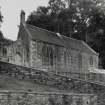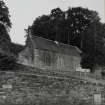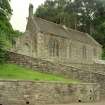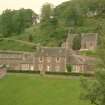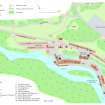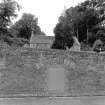Scheduled Maintenance
Please be advised that this website will undergo scheduled maintenance on the following dates: •
Tuesday 3rd December 11:00-15:00
During these times, some services may be temporarily unavailable. We apologise for any inconvenience this may cause.
New Lanark, New Lanark Road, New Lanark Church
Church (19th Century), Community Centre (20th Century)
Site Name New Lanark, New Lanark Road, New Lanark Church
Classification Church (19th Century), Community Centre (20th Century)
Alternative Name(s) Church Of Scotland; Community Hall; New Lanark Mills; New Lanark Industrial Village
Canmore ID 122790
Site Number NS84SE 58.09
NGR NS 88014 42650
Datum OSGB36 - NGR
Permalink http://canmore.org.uk/site/122790
- Council South Lanarkshire
- Parish Lanark
- Former Region Strathclyde
- Former District Clydesdale
- Former County Lanarkshire
NS84SE 58.09 88014 42650
Single storey, 4-bay, rectangular-plan, simple Gothic church with W gable belfry and porch adjoining W gable, at right angles to main axis of church. Snecked pink sandstone with polished yellow ashlar dressings. Base course, eaves course. Long and short quoins. Regular fenestration to N & S elevations with roll-moulded hoodmoulds and tabbed, chamfered margins. 2-leaf timber-boarded door to gabled lobby-porch. Cross finial to E gable.
Ecclesiastical building no longer in use as such (since 1971). It was sold by the Church of Scotland to the New Lanark Association Ltd in 1974 and now serves as a community hall. The church occupies a very prominent position at the bottom of the main footpath entering New Lanark. Though simple in design the detailing of the church is good both inside and out and reflects the training and early years of the architect Thomas Carlaw. Carlaw was born in 1851 and trained as a joiner. By the 1880s he was running a successful joinery business in Lanark though clearly he was willing to turn his hand to a variety of jobs, as he is variously described as joiner, cartwright and clerk of works. He may have been responsible for the design of the new school in New Lanark which was opened in 1884; certainly he is listed with his partner 'Murray' (probably a member of his future wife's family) as undertaking the joinery work there.
The church post-dates Dale's and Owen's involvement with the village by more than 50 years. The fact that they did not provide a church for the mill-workers (other than the New Buildings and later the Institute for the Formation of Character, where religious services of sorts could be held) indicates Dale's attitude to the established church and Owen's strong opposition to organised religion. David Dale had deep religious beliefs and founded the Old Scotch Independents, known as Daleites. He did not approve of the established church but provided meeting rooms for his and three other sects in the village. Owen denounced what he described as 'absurd and irrational forms of religion' but made some provision for religious observance in the Institute.
Henry Birkmyre, proprietor of the Gourock Ropework Company who acquired the mills in 1881, was a staunch supporter of the United Presbyterian Church. He was keen that the workers attended formal church services and tangled with the workers over the provision of a church. In the end he gave the site for the church free of charge as well as paying for the installation of electric power. The foundation stone was laid on 15 October 1898 and it was opened in June 1899. The church provided accommodation for 250 people and cost £1200, much of which was raised by subscription.
New Lanark village is made up of industrial, residential and community buildings, dating predominantly from between 1786 and the 1820s. The mill complex was founded by David Dale, Glasgow merchant, in conjunction with Richard Arkwright, trailblazing inventor of the cotton industry. Dale's humane philosophy was expanded by Robert Owen, who took over management of the mill village in partnership from 1799-1825. The mills were in operation from 1786 to 1968. (Historic Scotland)
















